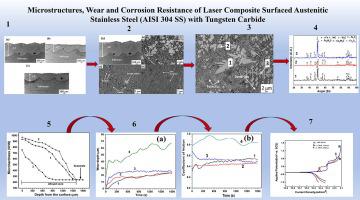Optics & Laser Technology ( IF 4.6 ) Pub Date : 2020-09-10 , DOI: 10.1016/j.optlastec.2020.106585 Amitesh Chakraborty , Jeetendra Kumar Singh , D. Sen , Sisa Pityana , I. Manna , Shree Krishna , J. Dutta Majumdar

|
This study aims at the development of composite surface on austenitic stainless (AISI 304 stainless steel) by laser surface alloying with WC and Co in the weight ratio of 4:1. Laser processing has been carried out by laser melting of sandblasted AISI 304SS using a 5 kW continuous-wave Nd: YAG laser having a beam diameter of 3 mm and simultaneous addition of powder (WC and Co in the ratio of 4:1) at a rate of 10 mg/sec using He as shroud (at a flow rate of 6 l/min) in the melted surface. The process parameters are applied power (1.75–2 kW) and scan speed (12–30 mm/sec) with a powder feed rate of 10 mg/s. The laser-treated surface has been subjected to microstructural investigation and wear resistance (fretting wear behaviour) testing. There is formation of different carbides (WC, W2C, Fe7C3, Cr23C6, Fe6W6C, and Co6W6C) in the gamma matrix of the treated zone. The microhardness of composite surface is significantly higher (980 VHN) than that of AISI 304SS (242 VHN). The fretting wear kinetics and coefficient of friction (COF) of the composite surface are reduced as compared to the substrate. The mechanism of wear has been established.
中文翻译:

碳化钨激光复合表面奥氏体不锈钢(AISI 304 SS)的组织,耐磨性和耐蚀性
这项研究的目的是通过以重量比4:1与WC和Co进行激光表面合金化,开发奥氏体不锈钢(AISI 304不锈钢)上的复合表面。激光加工是通过使用光束直径为3 mm的5 kW连续波Nd:YAG激光对喷砂AISI 304SS进行激光熔化并同时以5%的粉末添加粉末(WC和Co的比例为4:1)进行的。在熔化的表面中,用He作为覆盖物(流速为6 l / min)以10 mg / sec的速率加热。工艺参数为施加功率(1.75–2 kW)和扫描速度(12–30 mm / sec),粉末进料速度为10 mg / s。激光处理过的表面已经进行了微结构研究和耐磨性(微动磨损行为)测试。形成了不同的碳化物(WC,W 2 C,Fe 7C 3,Cr 23 C 6,Fe 6 W 6 C和Co 6 W 6 C)在处理区的γ矩阵中。复合材料表面的显微硬度(980 VHN)明显高于AISI 304SS(242 VHN)。与基材相比,复合材料表面的微动磨损动力学和摩擦系数(COF)降低了。磨损机理已经建立。











































 京公网安备 11010802027423号
京公网安备 11010802027423号